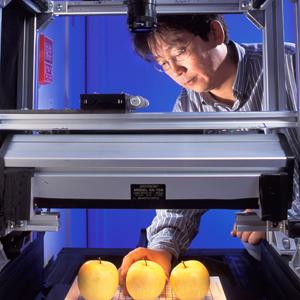
This is the VOA Special English Agriculture Report.
Europe's deadly outbreak of a rare form of E. coli bacteria has brought new attention to food safety issues. One of the problems when people get sick from food is that the simplest question is often difficult or even impossible to answer. Just what did the people eat that made them sick?
Of course, one way to avoid these medical mysteries is to keep dangerous organisms out of the food supply. This is easier said than done, but scientists keep looking for new ways.
Scientists in the United States have developed an experimental system that uses a high-tech optical scanner. The inspection system is meant for packing houses where produce is sorted for market.
The system is designed to identify the presence of contaminants like soil or animal waste on fresh produce. These can be sources of Escherichia coli, better known as E. coli. E. coli bacteria naturally live in the intestines of humans and many animals. Most kinds of E. coli are harmless but some can make people sick.
The new scanner can also show damage and imperfections that might make the produce unappealing to shoppers.
Scientists designed the system at a Department of Agriculture research center in Beltsville, Maryland. Moon Kim of the Agricultural Research Service led the team.
MOON KIM: "We were requested, we were asked, to develop a method to detect contamination in produce. So we started with the apple as the model sample."
The scanner uses a high-speed camera placed over the conveyer belt that moves the produce along. As the apples move along the belt, the scanner captures images of each piece of fruit.
The system is equipped with an ultraviolet lamp and a halogen lamp that produces near-infrared light. A spectrograph device can use the near-infrared light bouncing off an apple to show evidence of damage. The ultraviolet light can show contaminants.
Moon Kim says the team hopes the system will be available before long.
MOON KIM: "We are targeting for using commercial plants for the next several years."
The scanner can direct a sorting machine to separate the bad apples from the good ones. The system is currently able to show the surface of only half the apple as it speeds by. The inventers hope to improve the process so it can show the whole surface.
And that's the VOA Special English Agriculture Report, written by Jerilyn Watson. You can watch captioned videos of our reports at the VOA Learning English channel on YouTube. I'm Bob Doughty.
E. coli: a bacterium commonly found in the intestines of humans and other animals, where it usually causes no harm. Some strains can cause severe food poisoning, esp. in old people and children. 大腸桿菌
ultraviolet: using electromagnetic waves that are just shorter than those of violet light in the spectrum and that cannot be seen 紫外線的;利用紫外線的
halogen: halogens, in the form of gas, are used in lamps and cookers/stoves. 鹵素
Advisers want food safety laws to be better enforced
Experts seek end to food double standard
Investigation heats up on scandal-hit bakery
New law in US aims to increase food safety
(來源:VOA 編輯:崔旭燕)
